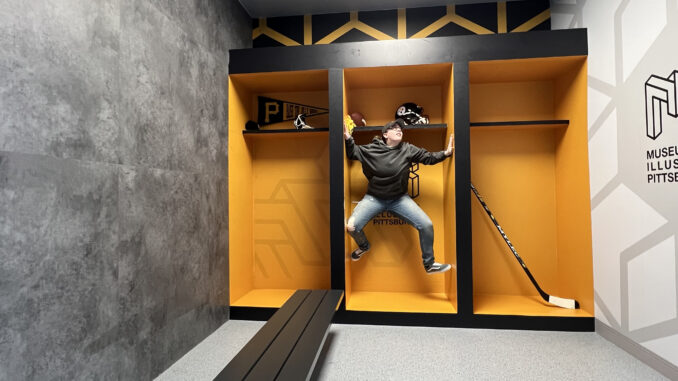
Emily Fritz | A&E Editor
Among the staples of the North Side, the paradox of choice can lead us into the lull of tiredness. Despite the current exhibit at The Andy Warhol Museum, the knowledge that pours regularly from the Carnegie Science Center or the revolving contemporary works at the Mattress Factory, the venue at 267 North Shore Drive assumes the persona of a bold new attraction.
Unfortunately, this one-level mirage is easy to confuse with a “Ripley’s Believe It Or Not!”
Since its opening on Dec. 21, the Museum of Illusion has revealed nearly every cheap card in its hand in an effort to lure in customers.
The chain museum charges $25 per adult, $23 for seniors and military and $20 for children between 5 and 12.
Even with illusion rooms, installations, images and the “Smart Playroom,” the walkthrough experience averages 60 minutes, almost 50 cents per minute.
Illusion rooms include the “Vortex Tunnel” (which features an illusion identical to that of “Noah’s Ark” in Kennywood), the “Ames Room,” the “Tilted Room” and a “Reverse Room” loosely inspired by Pittsburgh sports teams.
Of these four cliches, only half are wheelchair accessible due to slanted flooring.
“What we really love about this place is that we say we are an edutainment company,” Kenny Mckernan, the sales and marketing coordinator for the museum told CBS News.
“We educate you and we entertain you…[and] next to all the illusions, we offer a little explanation on why your brain is seeing it that way, why your eyes interpret it that way.”
While each of the interactive spaces plays with depth, distance and perspective and offers nuggets of knowledge for visitors to understand the illusion and experience, the majority are reaped from exhausted parts of the Internet or childhood books.
The disappointment was echoed by other museum goers with high hopes for Pittburgh’s newest addition. Several visitors took to Google reviews to air their grievances and warn others to stay away.
“Very little thought was put into the logistics of the [museum] and most illusions were what you might expect from a 7th grade science class. [T]here were a handful of cool effects and photo [opportunities], but definitely not worth the money,” visitor Bill Wilkison said while reviewing his visit.
Installations like “Head on a Platter,” the “Cloning Table” and the “Beuchet Chair” offer these lens-worthy moments, but the image-based illusions make up the larger part of the museum’s collection.
“It’s a typical Instagram-style pop up museum. It is fun to go to once!…There are 80 optical illusions but about 65 of them are pictures on a wall,” added visitor Grace Muller.
Perhaps the only saving grace for the new establishment is the “Smart Playroom,” a sit-down area that provides hands-on puzzles and sudoku-like games.
For the dedicated few willing to spend lengthy periods of time in one place or the spatial reasoning wizard, these intellectually challenging pieces can extend the visit, making the price point seem less harsh.
For those looking for more exploratory or exclusive experiences, there is little left for the Museum of Illusions to offer.
“[S]ome of [these exhibits are] tailored specifically for the Pittsburgh experience,” said Museum of Illusions Director of Sales and Marketing Stacy Stec in a news release.
The “Reversed Room” features a Pittsburgh locker room, adorned in black and gold, rotated 90 degrees.
The homage to the Steel City is smashed into one small space, featuring a Pirates flag, a Steelers helmet and Terrible Towel and a Penguins hockey stick.
Using the generic setup that the company has used at other locations and painting it to match its geography hardly qualifies as a tailored experience.
Likewise, the Museum of Illusions attempted to form relevant connections to other museums and Pittsburgh history by partnering with The Warhol Student Assistant Program.
“Golden Hour in Pittsburgh,” created by Makenzie Sing, Greg Kelly and Alexia Tsoukalas from the Creative and Performing Arts high school, draws inspiration from “Warhol’s high contrast graphic Pop Art portraits and his early ink illustrations of birds,” according to the museum’s description.
While these students demonstrate proficient awareness of Warhol’s impact on popular culture and a talent for mimicry, the Museum of Illusions hardly produced an installation worthy of applause.
The collaboration repackages another generic find in the Museum of Illusions located in other areas of the country – a mural portrait whose eyes “follow” you across the room. While the The Warhol Student Assistant Program contributed a worthy attempt, the Museum of Illusion stunted their potential by giving them little opportunity for creativity.
Sadly, the introduction of the venue is a one trick pony. The experience fails to live up to the greatness of other Pittsburgh museums by skimping on heritage, gutting itself of storytelling opportunities, gouging prices and failing to innovate.
If you are that desperate for an Instagrammable photo op, head to Randyland.
